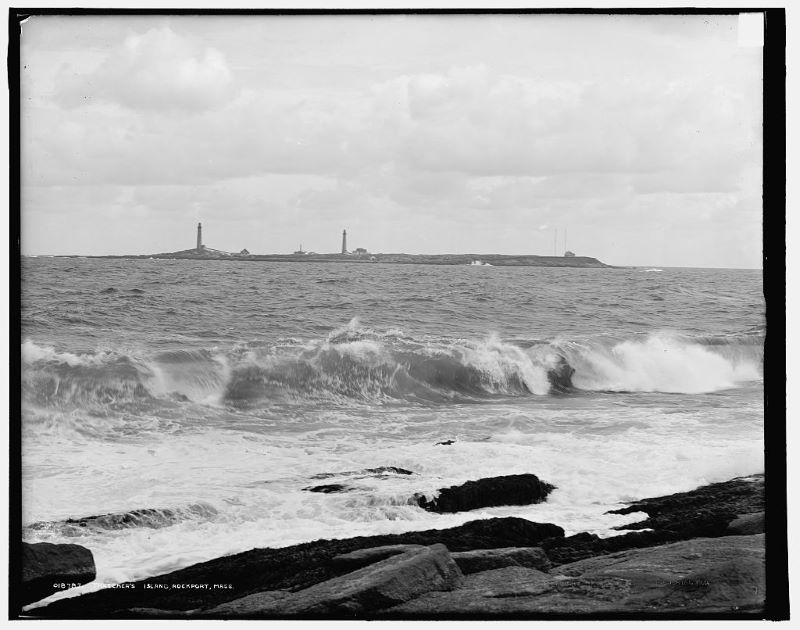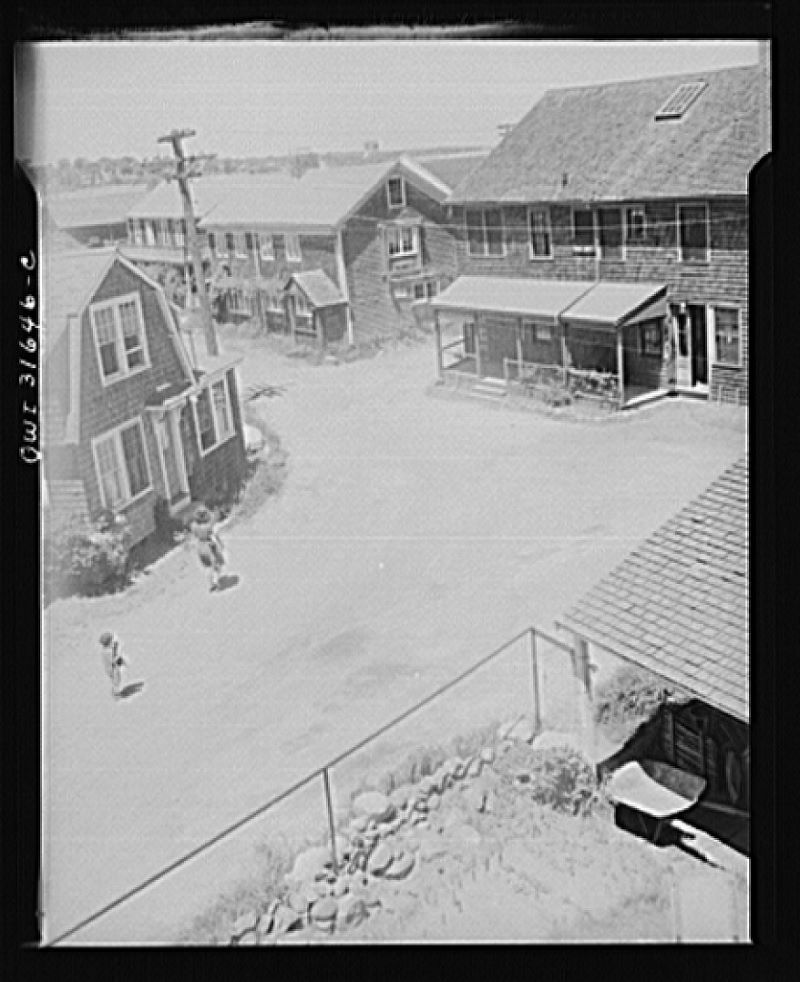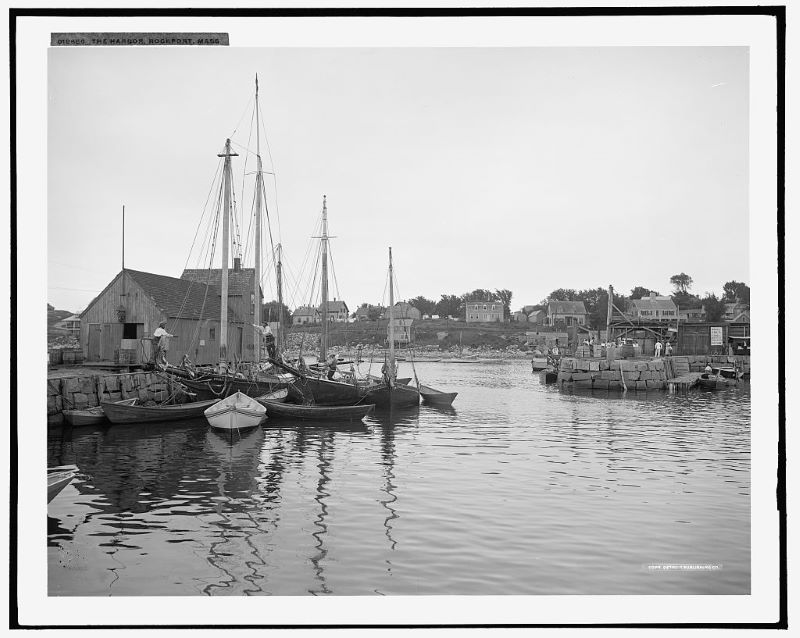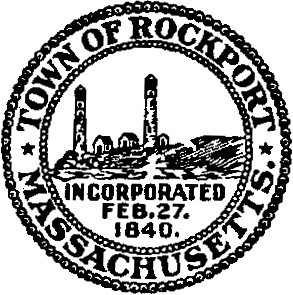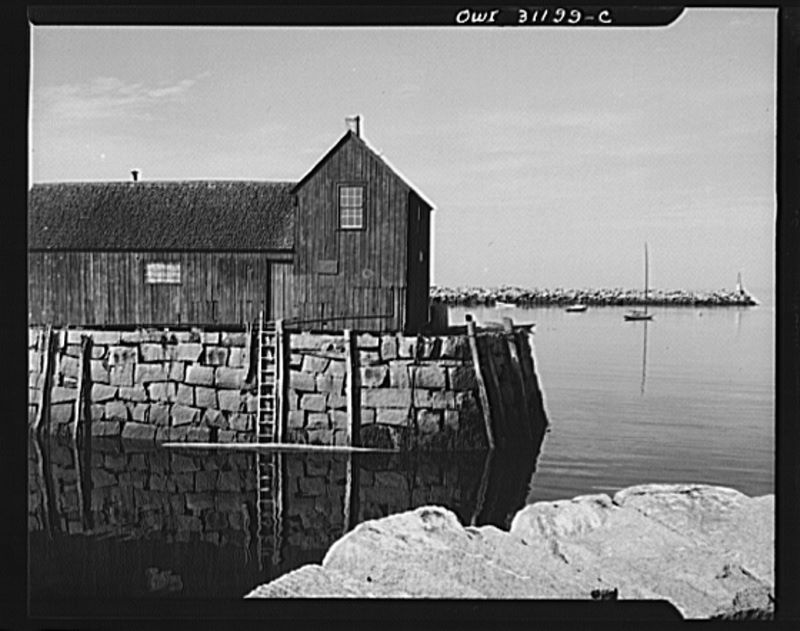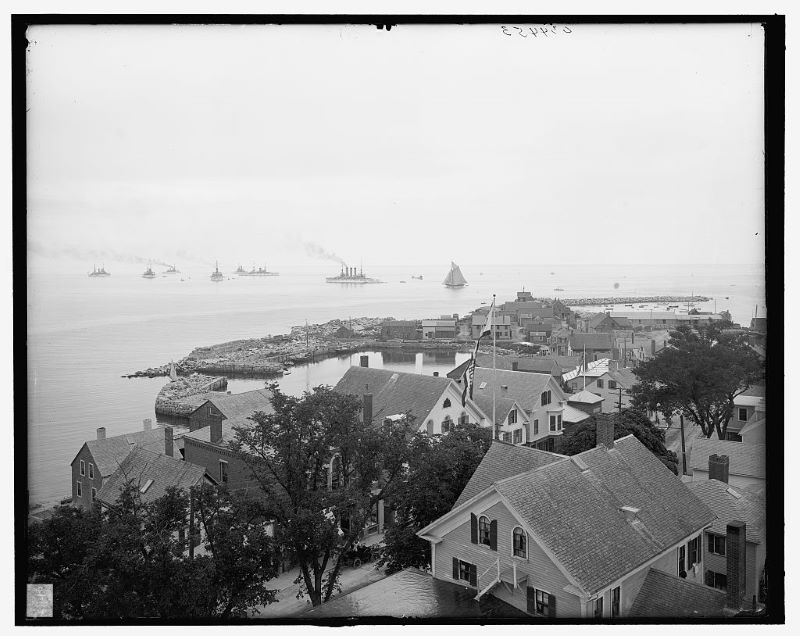Rockport is a historic town in Massachusetts. Originally inhabited by Agawam Indians, it was later settled by Massachusetts Bay colonists in the late 17th century as a fishing village.
The following is a timeline of the history of Rockport, Massachusetts:
1635:
- On August 15, a ship carrying Reverend John Avery, his cousin Antony Thacher and their families is wrecked on Crackwood’s Ledge during a storm. Thatcher and his wife are stranded on what is now Thacher Island and are later rescued by a passing ship.
1690:
- Richard Tarr settles Rockport as a small fishing village known as Sandy Bay.
1700:
- The Old Garrison House, also known as the Witch House, is built on what is now Granite Street. Local legend suggests that Elizabeth Proctor was banished from Salem after the Salem Witch Trials and lived in this house in exile but there is no evidence to support this claim.
- The Richard Tarr – Joseph Braga House, a Colonial-style house, is constructed on Main Street by Rockport’s “first settler” Richard Tarr.
- The Zebulon Parsons House, a salt box-style house, is built by Zebulon Parsons on South Street.
1705:
- The Caleb Marchant House is built on Granite Street.
1707:
- The Samuel Lane Jr House is built on Granite Street.
1710:
- The Solomon Norwood House, a Colonial-style house, is built on Atlantic Avenue.
1715:
- The Old Castle, a Colonial-style house, is built on what is now Castle Lane and earned its nickname due to the fact that it sits high at the top of a looming hill.
- The Gott House, a Colonial-style house, is built on what is now Gott Avenue.
1720:
- The John Tarr House is built on Mill Lane.
1725:
- The William Tarr House, a Colonial-style house, is built on the corner of a lot owned by William’s father, Richard Tarr, on Main Street.
1727:
- Old Parish Burying Ground is established on Beach Street.
1736:
- The Charbery Guest House, a Victorian Eclectic-style house, is built on Mount Pleasant Street.
1740:
- The Clark House, a Colonial-style house, is built on Beach Street.
- The Hannah Jumper House, a Colonial-style house, is built on Mount Pleasant Street and later becomes home to local temperance leader Hannah Jumper in the 19th century.
1741:
- The Old Rockport Road to Dogtown is constructed.
1745:
- The Captain John Gott House, a Colonial-style house, is built on Mount Pleasant Street.
- The Caleb Norwood House is built on Mount Pleasant Street.
1750:
- The Ebenezer Pool Log School House, a one-story log house that served as a school, is built on Beach Street.
- The Michael Knowlton House, a Greek Revival-style house, is built on Beach Street.
- The Samuel Gott Jr House is built on Granite Street.
- The Benjamin Tarr House, a Colonial-style house, is built on South Street.
- The Rockport Women’s Vacation Lodge is built on South Street.
1752:
- Local legend states that a teenage boy named Caleb Norwood discovered pirate treasure at Gully Cove this year and later becomes a wealthy landowner in Rockport who goes on to build several houses in the area.
1753:
- The Reverend Ebenezer Cleaveland House is built on Main Street and later serves as the Granite Shore Inn.
1754:
- The Andrew J. Woodbury Jr House is built on Curtis Street.
- Sandy Bay Colony is designated a parish of Gloucester and a meetinghouse is erected at Long Cove.
1756:
- The Stephen Gott Jr House is built on Curtis Street.
1760:
- The John Burnam House is built on Granite Street.
- The Mark Grimes House, a Colonial-style house, is built on Union Lane.
1764:
- The John Gott House, a Georgian-style house, is built on Pleasant Street.
1765:
- The Jabez Tarr House, a Colonial-style house, is built on Main Street.
1771:
- The James Norwood House is built on Granite Street.
- The John Blatchford House is built on Granite Street.
1775:
- The Punch Bowl Tavern – Washington Tarr House, a Georgian-style house that served as a tavern, is built for the Tarr family on Bearskin Neck Road.
1778:
- The Stephen Krutsford House is built on Curtis Street.
- The Ebenezer Pool House is built on King Street.
1780:
- A fish house is built on Bearskin Neck Road.
1787:
- The Josiah Haskell House, a Federal-style house, is built on Main Street.
1790:
- The Major John Rowe House, a Federal/Greek Revival-style house, is built on Rowe Avenue.
- The Seven South Street Inn, a Federal-style house, is built on South Street.
1791:
- The Jonathan Wheeler House, a Federal-style house, is built on Granite street.
- The Caleb Norwood House, a three-story Federal-style house, is built on Mount Pleasant Street.
1794:
- The John Rowe House, a Federal-style house, is built on Main Street.
1792:
- The Samuel Wheeler House, a Federal-style house, is built on Granite Street.
1793:
- The Annie Rowe House, a Colonial-style house, is built on Beach Street.
1796:
- The William Norwood House, a Federal-style house, is built on King Street.
1798:
- The Dr. James Goss – Caldwell House, a Federal-style house, is built on Main Street.
1799:
- The James Norwood House, also known as the Old Babson Farm, is a Federal-style house built on Granite Street.
1800:
- The Reverend Francis Norwood House, a Federal-style house, is built on Atlantic Avenue.
- The Ebenezer Pool House, a Federal-style house, is built on Dock Square.
- The Isaac Pool House, a Federal-style house, is built for Isaac Pool on Beach Street.
- The Mildred McDonald House is built on Bearskin Neck Road.
- The Turn Light Bottling Company is built on Broadway.
- The Florence E. Piper House, a Federal-style house, is built on High Street.
- The Deacon Abraham Poole House, a Colonial-style house, is built for Deacon Poole on High Street.
- The William Witham House, a Federal-style house, is built on King Street.
- The John Grist Pool Mill is constructed on King Street.
- The Jonathan Thomas Perkins House, a Federal-style house, is built on Main Street.
- The Mount Pleasant House Inn, a Federal/Greek Revival-style house, is built on Mount Pleasant Street.
1804:
- The Rockport Congregational Church is built on Main Street.
1805:
- The Daniel Wheeler Tavern is built on Granite Street and operated as a tavern until about 1850.
- The Caleb Norwood House, a Federal-style house, is built on High Street.
1815:
- Seawalls are constructed at Sandy Bay to protect the town from storms surges.
1816:
- The Twin Lights Assistant Keeper’s House is built on Thacher’s Island.
1820:
- A fish house is built on Bearskin Neck Road.
1829:
- The Rockport Old Engine House, a Victorian Eclectic-style fire house, is built on Beach Street to house the town’s two horse-drawn fire engine.
- The Universalist Church of Sandy Bay, a Gothic Revival-style building, is constructed on Cleaves Street.
1832:
- The Sewall – Scripture House, a Federal-style house constructed out of native granite, is built by granite quarry owner Levi Sewall on King Street.
1835:
- The Boston and Gloucester Granite Company Boarding House, a Greek Revival-style building, is constructed on Granite Street.
- The Straitsmouth Island Lighthouse Keepers House is built on Straitsmouth Island.
1840:
- The Granite Pier is constructed on Wharf Road.
- Rockport separates from Gloucester and is officially incorporated as a town in the Commonwealth of Massachusetts.
1845:
- The Chick’s Shoe Repair Shop, a Greek Revival-style building, is constructed on Granite Street.
- The Sail Loft building is constructed on Old Harbor Road and serves as a sail loft until 1942.
1846:
- A forge is built at 18 Middle Street and is also used as a fish house. It is later used as a new store and now serves as a private residence.
1850:
- The Eagle House Motel is built on Cleaves Street.
- The population of Rockport is 3,274.
1851:
- The Addison Choate Inn, a Greek Revival-style building, is constructed on Broadway.
1853:
- Union Cemetery is established on Union Lane.
1855:
- The Second Congregational Church, a Greek Revival-style building, is constructed on Broadway and later serves as an Odd Fellows Hall and then a Masonic Lodge.
- The Rockport Court House is built on Dock Square.
1856:
- On July 4, the town’s Independence Day celebrations turn into a large drunken brawl.
- On July 8, a group of 200 women, led by temperance leader Hannah Jumper, rampage through the streets of Rockport attacking businesses illegally selling liquor.
1860:
- The Beach Street Primary School, a Greek Revival-style school building, is constructed on Beach Street.
- The Rockport Baptist Church, an Italianate/Victorian Eclectic-style building, is constructed on Mount Pleasant Street.
- The population of Rockport is 3,237.
1861:
- The Boston and Maine Railroad tracks are constructed in Rockport.
- The Bradley Cooper Shop and Storehouse is built on Bearskin Neck Road.
- The Gilt Edge Cod – Howard Hodgkins Fish Company building is constructed on Bearskin Neck Road.
1864:
- The Annisquam Cotton Mill Picker House, a Classical Revival-style building, is constructed on School Street.
1865:
- The Rockport Steam Cotton Mills Boarding House, a Greek Revival-style building, is constructed on Broadway.
- The Old Rockport High School, an Italianate-style building, is constrcuted on Broadway.
- The Rockport Granite Company Store and Office building is constructed Granite Street.
1870:
- The First Methodist Church, a Victorian Gothic-style building, is constructed on Broadway.
- The population of Rockport is 3,904.
1871:
- The Timothy Sheahan Grocery Store, a Second Empire-style commercial building, is constructed on Broadway.
1872:
- The Granite Keystone Bridge is constructed on Granite Street.
- The Hilliard Frame Shop is built on Cleaves Street.
1875:
- The Rockport Steam Cotton Mills Worker Housing is built on Broadway.
1876:
- The Cape Ann Light Station Keeper House, a Gothic Revival-style house, is built on Thatcher’s Island to accommodate the light house keeper and his family.
1878:
- Two fish houses are built on Bearskin Neck Road.
- The Lewis Nickerson Grist Mill is built on Railroad Avenue.
1880:
- A fish house and Sound House is built on Bearskin Neck Road.
- The Kenneth B. Wilkinson Blacksmith Shop is built on High Street.
- The population of Rockport is 3,912.
1883:
- The Annisquam Cotton Mill is partially destroyed in a fire and the Annisquam Cotton Mill Picker House is later remodeled into the George Tarr School.
1884:
- The Commercial Cable Relay Station, a Victorian Eclectic-style building, is constructed on Norwood Avenue and serves as an important relay station for the first trans-Atlantic cable.
- Motif No. 1, the iconic red fishing shack, is constructed at the end of Bradley Wharf and is used to store gear and fish.
1885:
- More fish houses are built on Bearskin Neck Road.
1888:
- The Rockport Review Newspaper Office, a Colonial Revival-style building, is constructed on Bearskin Neck Road.
1889:
- The Twin Lights Oil House is built on Thatcher’s Island.
1890:
- The Favorite Fountain is constructed on Beach Street.
- The Finnish Lutheran Church is built on Forest Street.
- The Boston and Maine Railroad Freight House is built on Railroad Avenue.
- The population of Rockport is 4,087.
1892:
- The Bearskin Neck Transit Tower is built on Bearkskin Neck Road and serves as an observatory tower to survey the breakwater at the mouth of Sandy Bay.
- The Rockport Granite Company Headquarters Office building, a Second Empire-style building, is constructed on Granite Street.
1897:
- The Cod Liver Oil Manufactory is built on Bearskin Neck Road.
1900:
- Five Bradley Wharf Fish Houses are built on Bradley Wharf.
- The population of Rockport is 4,592.
1910:
- The Orchards Motel is built on Beach Street.
- The population of Rockport is 4,211.
1920:
- Ranta’s Market is built on Forest Street.
- The New England Bamboo Company is built on Granite Street.
- The George H. Todd Corporation Offices are built on Railroad Avenue.
- The population of Rockport is 3,878.
1922:
- The Paper House is built on Pigeon Hill Street out of layers of pressed newspaper by Elis F. Stenman. The house also features furniture made out of pressed newspaper.
1923:
- Two fish houses are built on Middle Road.
1925:
- The Rockport High School, a Colonial Revival-style building, is constructed on Broadway.
1928:
- The U. S. Post Office – Rockport Main Branch, a Colonial Revival-style building, is constructed on Broadway.
1930:
- The population of Rockport is 3,630.
1935:
- The Briar Swamp Damn is constructed in the Briar Swamp to keep the acidic swamp tannins out of the Babson Reservoir water supply.
1936:
- The Millbrook Meadow Park is established on Mill Lane.
1937:
- The Milly Hodgkins Strong Shop is built on Bearskin Neck Road.
1939:
- The Rockport Police and Fire Station, a Colonial Revival-style building, is constructed on Broadway.
1940:
- The Amethyst Shop is built on Doyle Cove Road.
- The population of Rockport is 3,556.
1942:
- The Boston Harbor Defense Station No. 136 – Tower Building, a Colonial Revival-style house with a concrete observation tower, is constructed on Gaffield Avenue in order to monitor the ocean and bay for enemy submarines.
1950:
- The Rockport Tee Shirt Shop is built on Bearskin Neck Road.
- The Dunkin Donuts shop is built on Railroad Avenue.
- The population of Rockport is 4,231.
1956:
- The Rockport Town Hall, a Colonial Revival-style municipal building, is constructed on Broadway.
1957:
- The Sewall-Scripture House is acquired by the Sandy Bay Historical Society and it becomes a historical house museum.
1959:
- The Peg Leg Motel, a Colonial Revival-style building, is constructed on Beach Street.
1960:
- The population of Rockport is 4,616.
1965:
- The Captains Bounty Motel is built on Beach Street.
1970:
- The Granite Savings Bank is constructed on Broadway.
- The population of Rockport is 5,636.
1975:
- The Islinglass Place Shops are built on Railroad Avenue.
1980:
- The population of Rockport is 6,345.
1982:
- The Boston Harbor Defense Station No. 136 – Tower Building becomes home to the Halibut Point State Park Headquarters.
1990:
- The population of Rockport is 7,482.
2000:
- The population of Rockport is 7.767.
2010:
- The population of Rockport is 6,952.
2020:
- The population of Rockport is 6,992.
Sources:
Gott, Lemuel and Ebenezer Pool. History of the Town of Rockport. Harvard University, 1888.
Parsons, Eleanor. The Making of a Tourist Treasure. Twin Lights Publishers, 1988.
MacNeill, Arianna. “How Hatchet-Weilding Women Ended Alcohol Sales in Rockport for 163 Years.” Boston.com, 28 Jan. 2019, boston.com/news/history/2019/01/28/hannah-jumper-hatchet-gang-rockport-alcohol/
“Hannah Jumper, 75, Rampages Against Rum in Rockport.” New England Historical Society, newenglandhistoricalsociety.com/hannah-jumper-75-rampages-against-rum-rockport/
Bliss, Abigail. “A New Chapter for the Hannah Jumper House.” Gloucester Daily Times, 14 Sept. 2017, gloucestertimes.com/news/local_news/a-new-chapter-for-the-hannah-jumper-house/article_68952743-8728-540c-a582-4d0c467be9dd.html
“Old First Parish Burying Ground.” Town of Rockport MA, rockportma.gov/dpw-cemetery-division/pages/old-first-parish-burying-ground
“Rockport Motif No. 1, The World’s Most Celebrated Fishing Shack.” New England Historical Society, newenglandhistoricalsociety.com/rockports-motif-no-1-the-worlds-most-celebrated-fishing-shack/
MACRIS, Massachusetts Historical Commission, mhc-macris.net/

